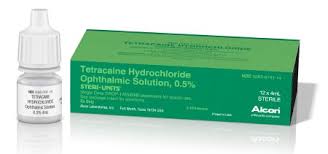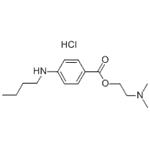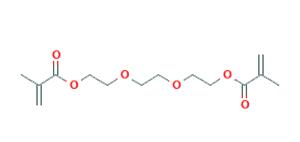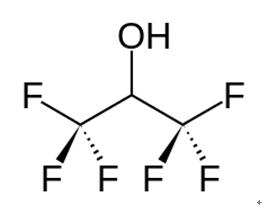Tetracaine hydrochloride – a local anesthetic widely used in clinic
Dec 30,2019
Tetracaine hydrochloride is a sterile aqueous topical anesthetic ophthalmic solution. The molecular formula is C15H24N2O2•HCl. and the molecular weight is 300.82. The melting point is 147-150 ℃. The active ingredient is represented by the chemical structure:

Tetracaine hydrochloride is a local anesthetic used to numb the eyes, nose, or throat. It may also be used before starting an intravenous to decrease pain from the procedure. Typically it is applied as a liquid to the area. Onset of effects when used in the eyes is within 30 seconds and last for less than 15 minutes [1].
Common side effects include a brief period of burning at the site of use.Allergic reactions may uncommonly occur. Long term use is generally not recommended as it may slow healing of the eye. It is unclear if use during pregnancy is safe for the baby. Tetracaine hydrochloride is in the ester-type local anesthetic family of medications. It works by blocking the sending of nerve impulses [2].

Tetracaine hydrochloride was patented in 1930 and came into medical use in 1941. It is on the World Health Organization's List of Essential Medicines, the most effective and safe medicines needed in a health system. The wholesale cost in the developing world is about US$1.34–1.63 per 10 ml bottle [3]. In the United Kingdom the eye drops cost the NHS about 0.49 pounds per dose.
Tetracaine hydrochloride is also known as ropivacaine hydrochloride, pantocaine, pantocaine and four ropivacaine hydrochloride. It is easily soluble in water and ethanol, but insoluble in ether, benzene. Tetracaine hydrochloride is a local anesthetic with long-acting ester. In addition, procaine is widely used in clinical, but because of its poor permeability and poor narcotic performance, a small tetracaine was found in 1930 found. Its fat solubility is 100 times than that of procaine, and its effectiveness and maintenance time also correspondingly increased. Compared to procaine, tetracaine hydrochloride has high performance on fat-soluble and anesthetic performance, and the anesthesia time is longer. Commonly, the tetracaine hydrochloride with 2% concentration is used for surface anesthesia, and 4%-5% ointment is formulated with an anhydrous machine to apply for skin surface anesthesia. It is also used for the tracheal catheter surface to reduce intraoperative airway irritation. Tetracaine hydrochloride can be used for topical anesthesia, and 0.05%-0.1% tetracaine hydrochloride can provide long-term and good effect of surface anesthesia. Meanwhile, tetracaine hydrochloride is still widely used in ophthalmic surface anesthesia, which has a long time for surface anesthesia and sensory resistance.
A systematic review investigated tetracaine for use in emergency departments, especially for starting intravenous lines in children, in view of its analgesic and cost-saving properties. However, it did not find an improvement in first-attempt cannulations [4].
Tetracaine hydrochloride is the T in TAC, a mixture of 5 to 12% tetracaine, 0.05% adrenaline, and 4 or 10% cocaine hydrochloride used in ear, nose, and throat surgery and in the emergency department where numbing of the surface is needed rapidly, especially when children have been injured in the eye, ear, or other sensitive locations.
In biomedical research, Tetracaine hydrochloride is used to alter the function of calcium release channels (ryanodine receptors) that control the release of calcium from intracellular stores. Tetracaine is an allosteric blocker of channel function. At low concentrations, Tetracaine hydrochloride causes an initial inhibition of spontaneous calcium release events, while at high concentrations, Tetracaine hydrochloride blocks release completely.
Tetracaine hydrochloride is a local anesthetic. It is widely used in clinic, which is often used for surface, infiltration and other local anesthesia. There are few manufacturers of tetracaine hydrochloride in the domestic market, and most of tetracaine hydrochloride products in the market come from abroad. The domestic production is far from meeting the market demand, and there are many problems existing in the production process, such as low yield, high cost, and harsh conditions and so on. By verifying the feasibility of the original route, a new synthetic route is proposed according to the experimental conditions. The synthetic route was optimized, and the effects of reaction factors on the reaction were determined by repeated experiments. Combined with the actual production conditions of industrialization, the industrial production line is determined. Wenli Li et al. investigated a simplified synthetic process which is suitable for industrial production [1].
References
[1] https://en.wikipedia.org/wiki/Tetracaine
[2] "Tetracaine". The American Society of Health-System Pharmacists. Archived from the original on 28 December 2016. Retrieved 8 December 2016.
[3] "Tetracaine". International Drug Price Indicator Guide. Retrieved 8 December 2016.
[4] Pywell, A; Xyrichis, A (2014). "Does topical Amethocaine cream increase first-time successful cannulation in children compared with a eutectic mixture of local anaesthetics (EMLA) cream? A systematic review and meta-analysis of randomised controlled trials". Emergency Medicine Journal. Emerg Med J. 0 (9): 1–5. doi:10.1136/emermed-2014-204066. PMID 25351196.
[5] Wenli Li, Jie Zhao, Yujie Cui, Study on the syhthesis process of tetracaine hydrochloride, International Symposium on Resource Exploration and Environmental Science, IOP Conf. Series: Earth and Environmental Science 64 (2017) 012108.
- Related articles
- Related Qustion
- Tetracaine Hydrochloride: A Comprehensive Overview Oct 25, 2024
Tetracaine Hydrochloride (TTC) is a long-acting local anesthetic commonly used for topical anesthesia.
- What is Tetracaine Hydrochloride Ophthalmic Solution Jun 14, 2024
Tetracaine Hydrochloride is a sterile aqueous topical anesthetic ophthalmic solution.
- Tetracaine hydrochloride: mechanism of action and activity Jun 21, 2023
Tetracaine hydrochloride is a versatile compound that exhibits multiple pharmacological activities, including potent antitumor effects, antibacterial properties, and long-acting local anesthetic.
Triethylene glycol dimethacrylate (TEGDMA) is a diester formed by condensation of two equivalents of methacrylic acid and one equivalent of ethylene glycol.....
Dec 30,2019Chemical Materials1,1,1,3,3,3-Hexafluoro-2-propanol also known as hexafluoroisopropanol, commonly abbreviated HFIP, is the organic compound with the formula (CF3)2CHOH. This fluoroalcohol finds use as solvent and synthetic intermediate.....
Dec 30,2019Organic reagentsTetracaine hydrochloride
136-47-0You may like
- Lidocaine hydrochloride: A local anesthetic
Mar 19, 2025
- What is Atracurium Besylate Injection
Apr 15, 2024
- General Introduction of Caffeine
Mar 3, 2022
Tetracaine hydrochloride manufacturers
- Tetracaine hydrochloride
-

- 2025-10-03
- CAS:136-47-0
- Min. Order:
- Purity: 0.99
- Supply Ability:
- Tetracaine hydrochloride
-

- $0.00 / 1kg
- 2025-10-03
- CAS:136-47-0
- Min. Order: 1kg
- Purity: 0.99
- Supply Ability: 900kg、
- Tetracaine hydrochloride
-

- $0.00 / 1G
- 2025-10-03
- CAS:136-47-0
- Min. Order: 1G
- Purity: 99%
- Supply Ability: 1 ton/year






